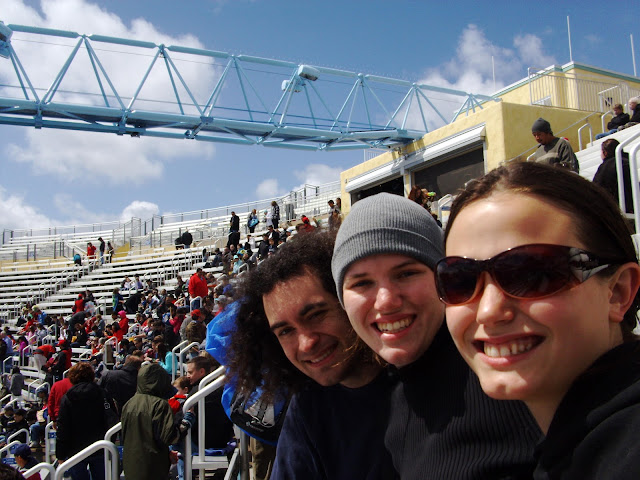Many people are baffled that I was ever able to save up enough money to travel. Although my online job was mostly responsible for my freedom, I didn’t make as much money as you’d think. All in all, the best way to get money for a trip is to save it. As my mom once pointed out to me, saving money is like earning tax-free income!
 |
Grocery-shopping is helpful
when you're on the road, too. |
If you want to save up money for a trip (or anything else), here are 10 things you can do, big and small, to make your dream happen:
1. Figure out if saving the money is worth it. If you really want to save up enough money for a trip, you can. But to do that, you may have to sacrifice an awful lot, and if you have children or a wife to take care of, then this issue is much bigger than just you. However, if you’re young, single, and healthy, there is nothing to keep you from taking your dream trip.
2. Make a budget. My monthly income fluctuates wildly, so my plan has always been to sit down when I get my paycheck and figure out how much I have left after tithe (10% of your income that goes to charity), rent, and basic bills. Then I divided that up among savings, groceries/supplies, and spending. Creating a budget takes about ten minutes and can save you hundreds of dollars over the course of the year.
 |
| Besides, DIY dessert is much more exciting! |
3. Stop going into debt. One of the biggest causes of debt is unnecessary college education. A few years ago, many of my friends and acquaintances were headed to college with no idea what to do or why they were attending. Now, many of them have dropped out, pursued other interests, or just graduated with no job, still no clue what to do, and a massive debt on their shoulders. If you don’t know why you’re going to college and you’re racking up a debt, stop. If you already have debt, make paying it off your top priority. Debt is enslaving, so only submit to it for a darn good reason.
4. Drop your smartphone, cable TV or Internet. Yes, I know. This is akin to asking someone to cut off their limbs. Believe me, though, it can be possible. A simple cell phone doesn’t have GPS or Fruit Ninja, but the drop in price might be worth it. Maybe you can forget cable and rely on Internet TV or Netflix, which continue to improve. Maybe you can do without Internet at all, relying on texting and free wi-fi hotspots for your e-mailing needs. Assess how much these things are worth to you, and if you need to, let them go.
5. Cut down or give up expensive habits. If you like to smoke, shop recreationally, buy comic books, visit the bar, drink gourmet coffee, go the movies, or dine at TGI Friday’s on a regular basis, take stock of what you’re doing. Is it really worth the money to you? Could you cut down on the frequency of these expensive habits to save money for something else? If you stopped a habit that cost you $3 a day, such as getting a fancy beverage at Starbuck’s every day, at the end of the year you’d have $1,095— enough for a round-trip plane ticket to Europe!
6. Shop for groceries and make your own food. Even an on-the-go person who hates to cook can find cheap and easy meals at grocery stores these days. Try being vegetarian one or two days a week to avoid purchasing expensive meat. Buy food on sale and eat whatever’s cheap.
 |
Sharpie doodling: prolong your jeans' life and make
yourself look like a cool indie kid in the process. |
7. Don’t impulse-buy. This applies to groceries as well as everything else. Impulse buying can be fun every once in a while, but never let it become a habit. Stick to your budget.
8. Try buying used instead of new. Thrift stores and Craigslist have never made it easier to get high-quality items for a ridiculously low price. If you’re trying to save money, it’s better to spend the extra time to root through the racks or the listings for higher-quality clothes, shoes, furniture and appliances for a much lower price than you could buy new. (Cheap Wal-Mart pants that last a few months: $10. Levi’s jeans bought at Goodwill that last two years: $6.)
9. Do little things to save money. Eat leftovers. Turn down the heat in your house in winter and up in summer. Put your spare change in a jar. Don’t leave lights on. Shower every other day. Walk somewhere instead of driving. Go on a picnic instead of out to a restaurant. Borrow movies and books from the library. Buy food in bulk and freeze it for later. Share resources. Barter.
10. Keep perspective. For some people, it’s not worth it to sacrifice their comforts for a longer-term goal. For others, it’s better to give up a lot in the present to make room for better things in the future. You have to decide what is important to you, and spend your time and money on that. For the past few years, travel was an essential part of my life, and so I was willing to give up a lot for it. I think the memories, skills, joys and perspectives I gained were well worth the little sacrifices. It’s up to you to decide what is important to you.
~~~




































